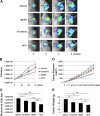6-Methoxyethylamino-numonafide inhibits hepatocellular carcinoma xenograft growth as a single agent and in combination with sorafenib
- PMID: 28821631
- PMCID: PMC5690379
- DOI: 10.1096/fj.201700306RR
6-Methoxyethylamino-numonafide inhibits hepatocellular carcinoma xenograft growth as a single agent and in combination with sorafenib
Abstract
Hepatocellular carcinoma (HCC) is the third leading form of cancer worldwide, and its incidence is increasing rapidly in the United States, tripling over the past 3 decades. The current chemotherapeutic strategies against localized and metastatic HCC are ineffective. Here we report that 6-methoxyethylamino-numonafide (MEAN) is a potent growth inhibitor of murine xenografts of 2 human HCC cell lines. At the same dose and with the same treatment strategies, MEAN was more efficacious in inhibiting tumor growth in mice than sorafenib, the only approved drug for HCC. Treatment by MEAN at an effective dose for 6 wk was well tolerated by animals. Combined therapy using both sorafenib and MEAN enhanced tumor growth inhibition over monotherapy with either agent. Additional experiments revealed that MEAN inhibited tumor growth through mechanisms distinct from those of either its parent compound, amonafide, or sorafenib. MEAN suppressed C-MYC expression and increased expression of several tumor suppressor genes, including Src homology region 2 domain-containing phosphatase-1 (SHP-1) and TXNIP (thioredoxin-interacting protein). As an encouraging feature for envisioned clinical application, the IC50 of MEAN was not significantly changed in several drug-resistant cell lines with activated P-glycoprotein drug efflux pumps compared to drug-sensitive parent cells, demonstrating the ability of MEAN to be effective in cells resistant to existing chemotherapy regimens. MEAN is a promising candidate for clinical development as a single-agent therapy or in combination with sorafenib for the management of HCC.-Liu, Y., Lou, G., Norton, J. T., Wang, C., Kandela, I., Tang, S., Shank, N. I., Gupta, P., Huang, M., Avram, M. J., Green, R., Mazar, A., Appella, D., Chen, Z., Huang, S. 6-Methoxyethylamino-numonafide inhibits hepatocellular carcinoma xenograft growth as a single agent and in combination with sorafenib.
Keywords: C-MYC inhibition; HCC therapeutic; MEAN; combination treatment.
© FASEB.
Figures






Similar articles
-
Hypoxia-mediated sorafenib resistance can be overcome by EF24 through Von Hippel-Lindau tumor suppressor-dependent HIF-1α inhibition in hepatocellular carcinoma.Hepatology. 2013 May;57(5):1847-57. doi: 10.1002/hep.26224. Epub 2013 Mar 14. Hepatology. 2013. PMID: 23299930
-
Discovery of novel Src homology region 2 domain-containing phosphatase 1 agonists from sorafenib for the treatment of hepatocellular carcinoma.Hepatology. 2014 Jan;59(1):190-201. doi: 10.1002/hep.26640. Epub 2013 Dec 9. Hepatology. 2014. PMID: 23908138
-
Dual inhibition of Akt and c-Met as a second-line therapy following acquired resistance to sorafenib in hepatocellular carcinoma cells.Mol Oncol. 2017 Mar;11(3):320-334. doi: 10.1002/1878-0261.12039. Epub 2017 Feb 17. Mol Oncol. 2017. PMID: 28164434 Free PMC article.
-
Deregulation of signaling pathways involved in sorafenib resistance of hepatocellular carcinoma.Klin Lab Diagn. 2013 Oct;(10):66-8, 34-7. Klin Lab Diagn. 2013. PMID: 24640100 Review. English, Russian.
-
Multiple Roles of Autophagy in the Sorafenib Resistance of Hepatocellular Carcinoma.Cell Physiol Biochem. 2017;44(2):716-727. doi: 10.1159/000485285. Epub 2017 Nov 23. Cell Physiol Biochem. 2017. PMID: 29169150 Review.
Cited by
-
Long non-coding RNA Gm15441 attenuates hepatic inflammasome activation in response to PPARA agonism and fasting.Nat Commun. 2020 Nov 17;11(1):5847. doi: 10.1038/s41467-020-19554-7. Nat Commun. 2020. PMID: 33203882 Free PMC article.
-
Prognostic comparative genes predict targets for sorafenib combination therapies in hepatocellular carcinoma.Comput Struct Biotechnol J. 2022 Apr 9;20:1752-1763. doi: 10.1016/j.csbj.2022.04.008. eCollection 2022. Comput Struct Biotechnol J. 2022. PMID: 35495118 Free PMC article.
-
Identification of Rad51 as a prognostic biomarker correlated with immune infiltration in hepatocellular carcinoma.Bioengineered. 2021 Dec;12(1):2664-2675. doi: 10.1080/21655979.2021.1938470. Bioengineered. 2021. PMID: 34115569 Free PMC article.
-
MiR-144-3p-mediated dysregulation of EIF4G2 contributes to the development of hepatocellular carcinoma through the ERK pathway.J Exp Clin Cancer Res. 2021 Feb 1;40(1):53. doi: 10.1186/s13046-021-01853-6. J Exp Clin Cancer Res. 2021. PMID: 33526055 Free PMC article.
-
Drug repositioning for pan-cancers of the digestive system: Identification of amonafide and BX795 as potential therapeutics via integrative Omics analysis.PLoS One. 2025 Jun 16;20(6):e0325700. doi: 10.1371/journal.pone.0325700. eCollection 2025. PLoS One. 2025. PMID: 40522954 Free PMC article.
References
-
- Ferlay J., Shin H. R., Bray F., Forman D., Mathers C., Parkin D. M. (2010) Estimates of worldwide burden of cancer in 2008: GLOBOCAN 2008. Int. J. Cancer 127, 2893–2917 - PubMed
-
- American Cancer Society. (2016) Cancer facts and figures. Accessed August 15, 2016 at: https://www.cancer.org/research/cancer-facts-statistics/all-cancer-facts....
-
- American Cancer Society. (2017) Liver and bile duct cancer—patient version. Accessed August 15, 2016 at: https://seer.cancer.gov/statfacts/html/livibd.html.
-
- Centers for Disease Control and Prevention. (2016) Viral hepatitis and liver cancer. Accessed August 15, 2016 at: https://www.cdc.gov/nchhstp/newsroom/docs/factsheets/viral-hep-liver-can....
MeSH terms
Substances
Grants and funding
LinkOut - more resources
Full Text Sources
Other Literature Sources
Medical
Research Materials
Miscellaneous

